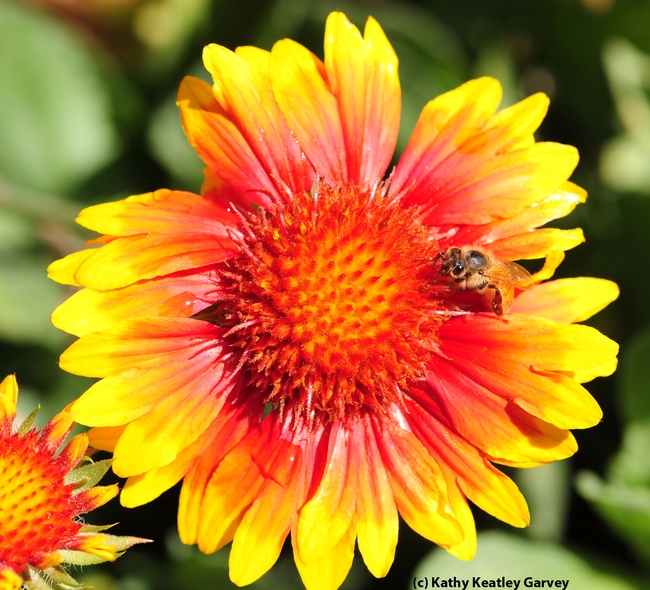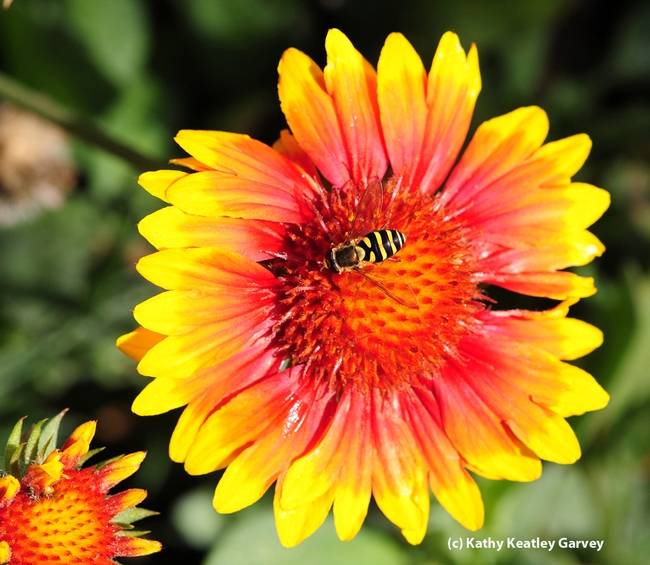About those honey bees...
Colony collapse disorder (CCD) has certainly increased public awareness about bees — but also public misinformation about bees in general.
CCD, the mysterious phenomenon characterized by adult bees abandoning the hive, leaving behind the queen bee, immature brood and stored food, surfaced in the winter of 2006. Scientists believe CCD is caused by multiple factors: diseases, viruses, pesticides, pests, malnutrition and stress.
Meanwhile, misinformation about bees continues to surface. Posts on Facebook, Twitter, Pinterest and other social media often caption a syrphid fly as a bee or a syrphid fly as a bumble bee. Magazine and newspaper editors frequently misidentify a syrhpid fly (aka flower fly and hover fly) as a honey bee. Even the cover of the well-respected book, Bees of the World, by Christopher O’Toole and Anthony Raw shows a fly, not a bee. University of Illinois-based entomologist Alex Wild, who received his doctorate from UC Davis, mentioned the error in his Scientific American blog.
So, we asked noted honey bee authority Eric Mussen, UC Cooperative Extension apiculturist based in the UC Davis Department of Entomology: What should the general public know about honey bees? Can you share some basic information? A honey bee primer?
First of all, honey bees are not native to the United States. European colonists introduced them to what is now the United States in 1622. The site: the Jamestown colony in Virginia. Then in 1853, the honey bees were introduced to California. The site: San Jose.
“Honey bees,” Mussen says, “are commercial pollination workhorses, while native bees — mostly solitary — pollinate the native plants of field and forest. Around 250 commercial California beekeepers operate about 500,000 honey bee colonies, approximately one-fifth of the country’s supply. Over 72 percent of commercial crop pollination is conducted in California, and about one-third of our daily diet is dependent upon bee pollination. We also have about 6,000 small-scale or hobby beekeepers, who tend to keep one to five colonies.”
Mussen attributes CCD with “fomenting great media and public interest. It also sparked an increase in the number of small scale beekeepers.”
About 60,000 individuals, including the queen, thousands of worker bees (sterile females) and drones (male bees) comprise a colony in the late spring/summer.
“Up to a thousand drones are present during the mating season,” Mussen says, “but they get evicted at the end of the fall.”
The drones serve one purpose: to mate with a queen. And then they die. When a virgin queen is about 10 days old, she will mate with 12 to 20 drones on one or more mating flights. The queen returns to the hive and begins laying eggs, as many as 2,000 eggs a day.
“Bees are vegetarians and live on pollen and nectar obtained from flowers or extra-floral nectarines,” Mussen says. “A mix of pollens is required to meet honey bee nutritional needs.”
During the active season, a honey bee colony each day requires an acre-equivalent of blooms in order to meet its nutritional needs. Bees store both pollens and honey for winter food. The bees usually forage within five miles of the hive. Nutrition is crucial to a healthy hive.
“Malnutrition impairs the protective physiological systems — particularly the immune system and detoxification system — and leads to less productive and shorter-lived bees,” Mussen says.
The bottom line: “More research is required to find better ways to reduce populations of honey bee parasites, reduce levels of honey bee diseases, and develop beekeeping management practices that prevent excessive losses of honey bee colonies during the year.”

Honey bee on blanket flower, Gaillardia. (Photo by Kathy Keatley Garvey)

This floral visitor, a syrphid fly, is often mistaken for a honey bee. (Photo by Kathy Keatley Garvey)
Comments:
Thank you for your comment. Extension apiculturist Eric Mussen of the UC Davis Department of Entomology, clarifies:
"In response to the statement: 'That leaves one factor that was not present earlier - pesticides - specifically neonicotinoids.'
"If exposure to field doses of neonicotinoid pesticides (usually less than 10 ppb) is considered to be the sole reason for honey bee colony demise, then why did colonies, fed 13 times during the season with a liter of sucrose syrup containing either 0.5 micrograms or 5.0 micrograms (0.5 and 5.0 ppb) of imidacloprid, survive all season and through the winter? This study was conducted in France by Jean-Paul Faucon, et al., and can be reviewed on the Internet at DOI: 10.1002/ps.957 or directly at http://europepmc.org/abstract/MED/15619715/reload=0;jsessionid=DGwkAFj1i8sjlwAOnB0V.8.
"Using sophisticated correlation analyses, no one cause for colony collapse disorder (CCD) distinguishes itself as being any more apt to cause the malady than any other single or multiple set of causes. It seems to be more of a “Perfect Storm” phenomenon." --Eric Mussen, Extension apiculturist.
Maybe its time to learn to work the "Africanized" bees. They've worked for us for over a hundred years and we never re queen either.
I wasn't able to read the complete study without paying for access. However, I have been following the news and the European Food Safety Authority has now effectively banned neonicotinoid pesticides.
http://www.guardian.co.uk/environment/2013/jan/16/insecticide-unacceptable-danger-bees



I don't believe this is the case. CCD has attacked hives that are not subject to the stress of being transported across the country. All of the other factors save one have been around for a long time without CCD occurring.
I believe that the current CCD outbreak is much, much larger in magnitude and scope worldwide than any previously documented outbreaks.
That leaves one factor that was not present earlier - pesticides - specifically neonicotinoids.
Posted by David Bennett on November 14, 2012 at 2:32 PM